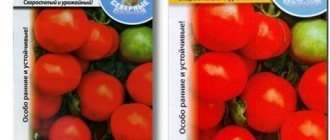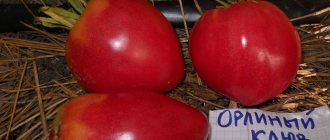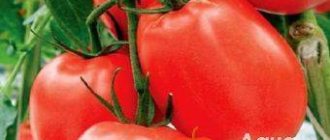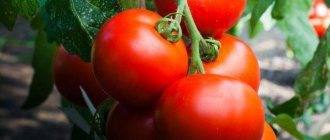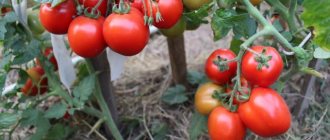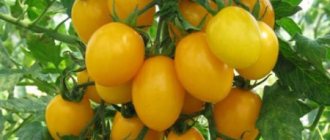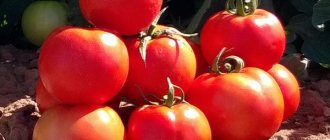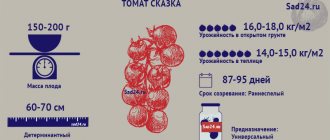Brown bunch f1 is an excellent tomato for canning whole fruits. Homemade tomato preparations are incredibly tasty and colorful. The hybrid is unpretentious in agricultural technology and is productive.
| Height | Landing location | Ripening time | Fruit color | Fruit size | Origin | Fruit shape |
| Tall | Greenhouse, Open ground | Early ripening | Bicolor | Average | Hybrid | Plum-shaped or oval |
Features of cultivation, planting and care
We recommend sowing the seeds of this tomato for seedlings 60-65 days before the intended planting in the ground. Seedlings dive at the stage of two true leaves. When planting seedlings in a permanent place per 1 sq. It is recommended to place up to 3 plants per meter of land; when forming into 1 stem - up to 4. Planting pattern 70 x 40 cm.
Further care for tomatoes consists of timely watering, fertilizing with complex mineral fertilizer, pinching and preventive measures to protect against diseases and pests.
The best black varieties of tomatoes for the greenhouse
In greenhouse conditions, as a rule, a higher yield is obtained. Especially when the greenhouse is heated. Here it is possible to plant seedlings of black tomatoes early. Plants that grow in a greenhouse are protected from bad weather conditions.
The best varieties of black tomatoes for growing in a greenhouse:
- Black Crimea;
- De Barao Black;
- Indigo Rose;
- Black Sun;
- Black Truffle;
- Black Baron;
- Kumato;
- Black Gourmet.
Advantages and disadvantages of black tomatoes
The most important advantage is the pronounced and rich taste and aroma.
The pulp contains many acids of organic origin and sugars.
The next reason why you should give preference to black-fruited tomatoes is the health benefits.
Due to the presence of anthocyanins, which are coloring substances, in black tomatoes, consumption of the fruit brings the following benefits to the body:
- strengthening protective properties;
- antitumor effect;
- beneficial effect on the heart and blood vessels;
- reduction of swelling;
- improvement of visual acuity due to the content of vitamin A precursor in tomatoes.
Black tomatoes for open ground - video
A varied diet with black tomatoes leads to an increase in the tone of the whole body, increased performance, and improved overall well-being.
Among the disadvantages, it is worth highlighting only the presence of very thin and delicate skin in some varieties, due to which the fruits do not hold their shape well enough.
Therefore, not all black-fruited tomatoes can be preserved in their entirety, but you can prepare tomato pastes and juices from them. This is a conditional drawback, because of which you should not refuse to grow them. The benefits of black tomatoes far outweigh their disadvantages.
The best varieties of black tomatoes: top 20 most popular
Note! The list of the best black tomatoes was prepared based on the degree of popularity of the names of varieties and hybrids, analysis of reviews from experienced gardeners, as well as the personal opinion of the author.
The most popular and best varieties of black tomatoes can be called (alphabetically):
By the way! The most common black varieties are the following (in order of popularity): Black Prince, Japanese Truffle and Black Moor
- three main hits, and then come - Chocolate, De Barao black, Watermelon,
Indigo rose, Black bunch F1 (completely black or, as they say, blue tomatoes) , Viagra , Marshmallow in chocolate, Gypsy, Chocolate.
Watermelon
- Mid-early (105-110 days from germination to fruiting).
- The plant is indeterminate (more than 2.0 m). The first inflorescence is laid above the 8-9 leaf, the subsequent ones - after 3 leaves. They are formed into one stem, removing all the “stepchildren” and tied to a support. At the end of the growing season, pinch out the growing point.
- For film greenhouses.
- The fruits are flat-round, ribbed, multi-chambered.
- Weight - 130-150 g.
- Productivity - 3.0-3.2 kg per plant (4.2-5.6 kg per sq. m).
- The fruits are fleshy, juicy and tasty. Recommended for preparing fresh salads.
- Resistant to temperature changes.
You may also be interested
Tomatoes
The best varieties of tomatoes for a window sill or balcony (loggia):…
Tomatoes
Top rot on tomatoes: how to treat (feed)…
Tomatoes
At what distance to plant tomatoes in a greenhouse and open...
Vegetables and greens
Is it possible to plant tomatoes and cucumbers in the same greenhouse, and how...
Viagra
- Mid-season variety (ripening occurs on the 112th day after full germination)
- The plant is indeterminate, tall. After planting, the plant is formed into one stem, removing all the stepsons.
- For growing under film covers (in a greenhouse).
- The fruits are flat-round, slightly ribbed, brown in color, with dense skin,
- Weight - 110 g.
- Productivity - 10 kg per sq.m.
- The sweet pulp has a rich taste and strong aroma.
- Resistant to cladosporiosis and tobacco mosaic virus.
Cherry black
- Early ripening variety, 112 days from germination to fruiting (according to other sources, 100-105 days).
- The plant is indeterminate (with unlimited growth), more than 2 m high. Form into one stem, removing all the “stepchildren”. When the 5th inflorescence is formed, the lower leaves begin to be removed 2-3 per week. After the formation of 8-10 brushes, the shoot is pinched, leaving 2 leaves above the last brush.
- For cultivation in film greenhouses.
- The fruits are round, brown in color (purple-brown). The number of nests is 2-3.
- Weight - 18-20 grams.
- Excellent dessert taste, cherry tomatoes are very sweet and juicy, with a bright, pleasant aroma.
- For preparing fresh salads, delicious appetizers and colorful canned assorted dishes.
- Productivity - 3.5 kg per sq.m (according to other sources, 6.5-7 kg).
Black pear
- Mid-season (from germination to ripening 110-115 days).
- The plant is indeterminate (with unlimited growth), up to 2.0 m high. Plants must be staked a few days after planting. Form into one stem, removing all the “stepchildren” and lower leaves, and also pinch off the growing point at the end of the growing season.
- For growing in film and glass greenhouses, as well as in open ground (with a garter to stakes).
- The fruits are pear-shaped, brown-burgundy, smooth, dense.
- Weight - 50-80 grams.
- Excellent taste.
- Recommended for fresh consumption and canning.
De Barao black
- Mid-season (115-120 days from germination to fruiting) tall variety
- The plant is indeterminate, medium-branched, medium-leaved, 2.3-2.7 m high. Requires staking and pinching. The first inflorescence is laid above the 9-11th leaf, the subsequent ones - after 3 leaves.
- For film and glazed greenhouses or for growing in open ground (in more southern regions).
- The fruit is oval-ovoid, dense, the color of the unripe fruit is green, with a dark spot, the color of the ripe fruit is violet-brown (dark cherry to black).
- Weight - up to 60 g (according to other sources, 50-70 grams).
- Productivity - up to 8.0 kg/sq.m.
- The taste is excellent. Universal purpose: recommended for fresh consumption and whole-fruit canning.
- Weakly affected by late blight. The variety is cold-resistant and shade-tolerant.
- Characterized by long-term fruiting.
Marshmallows in chocolate
- Mid-season variety.
- The plant is indeterminate, tall, requires shaping and staking.
- For film greenhouses.
- The fruit is round. The color is red-brown with dark green stripes. The number of nests is 4-6.
- Weight -120-150 g.
- Productivity - 5.7 kg per sq.m.
- The pulp is juicy, greenish in color and has excellent taste. For fresh consumption (salad use).
- Resistant to tobacco mosaic virus.
Ivan da Marya
- Early ripening variety. Fruiting occurs in 95-105 days (according to other sources, in 90-110).
- The plant is determinate (semi-determinant), up to 180 cm high, with weak foliage. Be sure to shoot into one or two stems, cut off the top, leaving 2 leaves above the brush (according to other sources, in closed ground, shoot and form at the expense of the last stepson).
- For open ground and greenhouses.
- The fruits are dense and round. The unripe fruit has a purple spot, the mature fruit is red-brown. The number of nests is 4-6.
- Weight - 200-210 grams.
- Productivity - up to 15 kg per sq.m (or up to 5 kg per plant).
- The taste is excellent, the fruit is fleshy. For fresh consumption and for all types of processing.
Indigo Rose
- Mid-season variety (according to other sources, early - 95-100 days).
- The plant is semi-determinate, medium-sized bush, 120 cm high.
- The fruits are round, smooth, dark blue-black in color, externally reminiscent of a plum (purple on the outside, red on the inside).
- Weight - 30-60 grams.
- The fruits are dense and fleshy. The taste of tomatoes is sweet.
- Universal purpose: such interesting fruits can be used both for fresh consumption and in the preparation of various dishes, canning, and pickling.
- Resistant to late blight and low temperatures (frosts down to -5 degrees).
It is superior to blueberries in anthocyanin content.
Striped chocolate
- Mid-season variety, from germination to the beginning of fruiting 115-120 days (according to other sources, 105-110 days).
- The plants are indeterminate, powerful, 1.5-2 m high. The first inflorescence is formed above the 9th leaf, the next after 3 leaves.
- The fruits are multi-chambered, flat-round in shape, weighing 250-350 g, with a smooth glossy surface, painted in a deep orange color with very frequent thin green stripes, strokes and strokes.
- Weight - 250-350 g (maximum up to 500 grams).
- Excellent sweet (fruity) taste with slight sourness and a strong, pleasant aroma. When cut, it has solid tomato “meat”, quite juicy, with a small number of seeds.
- Ideal for salads.
- Productivity - 8-10 kg per sq.m (according to other sources, 17 kg).
Unfortunately, the variety is tolerant to the main complex of tomato diseases.
Paul Robson
- Mid-season variety (105-110 days).
- The plant is semi-determinate, 1.2-1.5 m high. Requires pinching and staking. There are 3-5 fruits in a cluster.
- For greenhouses, film greenhouses and open ground.
- The fruits are flat-round, during ripening the color changes from green to reddish-brown, with a slightly chocolate tint, multi-chambered.
- Weight - 150-250 g (according to other sources, 250-300 grams).
- The fruits are fleshy, with “watermelon pulp”, very tasty. High in sugars and lycopene.
- Salad purpose: recommended for fresh consumption.
Brown sugar
- Medium late variety (115-120 days).
- The plant is indeterminate, tall, up to 2 m high.
- For growing in open ground and under film covers.
- The fruits are flat-round, dark burgundy and brown. The number of nests is 4-6.
- Weight - 120-150 grams.
- Productivity - 6-7 kg/m2.
- The fruits are fleshy, sweet taste.
- For salad purposes: recommended for fresh consumption, home cooking, and obtaining fresh medicinal juice.
- With long-term fruiting.
It has high medicinal anti-cancer and anti-infarction properties, prevents aging and belongs to the category of “rejuvenating apples”.
Gypsy
- Mid-season variety.
- The plant is semi-determinate. Requires staking and plant formation. The first inflorescence is laid above the 8-9 leaf, the subsequent ones - after 3 leaves.
- For film greenhouses and open ground.
- The fruit is round, medium ribbed. The color of the unripe fruit is green with a large dark green spot at the stalk; the mature fruit is purple-brown. The number of nests is more than 4.
- Weight - 100-180 grams.
- Productivity - 6.3-6.7 kg per sq.m.
- The taste is good or excellent. Recommended for fresh use.
Black bunch F1
- Early ripening hybrid.
- The plant is indeterminate, about 1.5 meters high.
- For open and closed ground.
- The fruits are plum-shaped, with a richly dark (black, blue) peel.
- Weight - 35-70 g (average - 45 grams).
- The fruits have a pleasant aroma and a plum aftertaste (fruit-plum taste).
Note! The pigment appears in the skin under the influence of sunlight at an early stage of ripening. With insufficient sunlight (in greenhouse conditions), the surface of the fruit is less saturated with black color.
Black gourmet
- Mid-season variety. The period from germination to ripening is 110-115 days.
- For film greenhouses.
- The plant is indeterminate, tall, requires shaping and staking.
- The fruits are round, dense, rich pomegranate (brown) color, with dark red to brown pulp. The number of nests is 4-6.
- Weight - 80-110 g.
- Productivity - 5.6 kg per sq.m.
- Fruits with excellent taste, tender, juicy, aromatic.
- Salad type: for fresh consumption.
Chernomor
- Mid-season variety (105-110 days).
- The plant is semi-determinate, 1.3-1.5 m high. Requires pinching and staking. There are 3-5 fruits in a cluster.
- For greenhouses, film greenhouses and open ground in the southern regions.
- The fruits are flat-round, dark burgundy, multi-chambered.
- Weight from 150-180 to 250-300 grams.
- Productivity - up to 4 kg per plant.
- The fruits are fleshy, juicy, very tasty.
- Salad purpose: recommended for fresh consumption.
Black Baron
- Mid-season variety. The period from germination to the beginning of ripening is 120-125 days.
- The plant is indeterminate, the bush is powerful, tall, up to 2 meters high, requires pinching and gartering on a support or trellis.
- For film greenhouses and open ground.
- The fruit is flat-round, strongly ribbed, of medium density, brown in color. The number of nests is more than 6.
- Weight 150-250 g.
- Productivity - 6.5 kg per sq.m (under film covers).
- It has excellent taste.
- Universal use: recommended for fresh consumption, preparation of tomato products and canning.
Black Moor
- Mid-season variety (110-115 days from germination to fruiting).
- The plant is indeterminate, medium-sized. The first inflorescence is laid above the 8-9 leaf, the subsequent ones - after 3 leaves. Up to 18 fruits can form on one brush.
- Recommended for glazed and film greenhouses.
- The fruits are plum-shaped (egg-shaped), dense, smooth, brown-brown, with a dark spot at the stalk,
- Weight - 40-50 grams.
- Productivity - up to 5.3 kg per sq.m. (according to other sources, even up to 6 kg per plant).
- The taste is excellent: the flesh is fleshy, juicy, sweet.
- Recommended for fresh consumption, excellent for whole-fruit pickling.
- Susceptible to blossom end rot during drought.
- The variety is well transported.
Black Prince
- Mid-season variety (110-115 days from germination to fruiting).
- The plant is determinate, medium-sized, 1-1.5 m high (according to other sources, indeterminate, up to 2 meters high).
- Recommended for open ground (with a tie to stakes), glazed and film greenhouses.
- The fruits are flat-round, ribbed, dense, dark red with a black tint.
- Weight - 250 g (200-400 grams).
- Productivity - 6-7 kg per sq.m.
- Salad purpose: recommended for fresh consumption. The pulp is fleshy, juicy, sweet (dessert taste).
- Relatively resistant to late blight.
Black Russian
- Mid-season variety (110-115 days from germination to ripening).
- The plant is indeterminate, tall, up to 250 cm high.
- For open ground and film shelters.
- The fruits are flat-round, ribbed. The color is unusual - the fruit is black-crimson on top, crimson (or purple-brown) below.
- Weight - 170-250 grams
- Very tasty, sweet. Salad purpose.
- Relatively resistant to major tomato diseases. It has good tolerance to low light and temperature changes.
Black chocolate
- Mid-season variety.
- The plant is indeterminate, tall, requires shaping and staking. There are 10-12 pieces on a brush.
- For film greenhouses.
- Cherry fruits are round, uniformly brown in color with a green spot at the stalk. Number of nests - 2.
- Weight - 20-28 g.
- Productivity - 4.7 kg per sq.m.
- Sweet, with fruity cherry flavor.
- Salad purpose: for fresh consumption.
Chocolate F1
- Mid-season hybrid (115-120 days).
- The plant is indeterminate, 1.8-2 m high, requires staking and shaping. The clusters are simple, long, containing 9-11 fruits.
- For open ground and film shelters.
- The fruits are elongated plum-shaped, brown with dark green stripes.
- Weight - 30-40 g
- Productivity - 6-6.2 kg per sq.m.
- The fruits are juicy and sweet, with an exquisite taste.
- Recommended for fresh consumption and all types of culinary processing.
- Resistant to major diseases and temperature fluctuations.
Chocolate
- Medium early variety.
- The plant is semi-determinate, 110-150 cm high.
- Designed for cultivation in film greenhouses and open ground.
- The fruits are multi-chambered, flat-round in shape, brown in color, with orange-brown tender pulp.
- Weight - 200-400 g.
- Productivity - 4.2 kg per sq.m.
- The fruits are very tasty, sweet, fleshy.
- Recommended for preparing salads, side dishes, jams, and all types of home cooking.
- Resistant to crown and root rot.
Japanese truffle black
- Mid-season variety, from germination to fruiting 111-115 days.
- The plant is indeterminate, 1.5-2 meters high. Form into 1-2 stems, leaving 4-5 clusters of 5-6 fruits on the stem.
- For greenhouse cultivation (in the middle zone) and open ground (in the south).
- The fruits are black-brown, glossy, very dense. Truffle shape.
- Weight - 100-150 g.
- Productivity - up to 4 kg per plant.
- The fruits are fleshy. The taste is sweet and sour; the sweetness intensifies during storage. Universal purpose: for preparing salads and whole-fruit canning.
- Green fruits picked at the end of the season ripen well and are stored until the New Year.
- Brushes must be protected from creases.
Other varieties of black tomatoes
Of course, there are a sufficient number of, albeit slightly less known, but quite good and proven varieties of black (brown) tomatoes, among which the following can be distinguished:
- Shadowboxing series "Gnome" (has a very rich black tint);
- Bison black;
- Bull's heart is black;
- Viagra;
- Uncle Styopa;
- Calvados;
- Red coal;
- Creme brulee;
- Crimean Black (or Black Crimea);
- Cuban black;
- Monisto chocolate;
- Chocolate cream;
- Black icicle;
- Carbon;
- Black plum;
- Blueberries (have a very rich black tint);
- Black Iceberg;
- Black Pearl;
- Black elephant;
- Chocolate Amazon;
- Chocolate block;
- Chocolate miracle.
Thus, as you already understand, black tomatoes not only look attractive and unusual, but at the same time they taste very good and are healthy. Therefore, if you are also drawn to black varieties of tomatoes, now your goal is to choose those options that are more suitable for growing on your site. In this case, it is important to pay attention to their ripening time, taste (although they are almost always excellent) and appearance (if you want to have fruits of an unusual shape).
Video: the best varieties of black tomatoes
What are the features of black tomatoes?
In general, black tomatoes are not too different from the rest of the tomato crop. The bush form, the color of ripening fruits, leaves, all this exactly corresponds to the characteristics of other tomatoes.
The dark color is obtained by mixing red and violet.
Lycopene and carotenoids give tomatoes their traditional red hue, and anthocyanins give vegetables their purple color (for example, eggplants, beets, and others).
There are differences in taste:
black varieties of tomatoes are sweeter, as they contain a higher sugar content.
Growing, care, beneficial properties of black tomatoes - video
Description
The plant is indeterminate. In the conditions of central Russia it can grow up to 3.0 - 3.5 meters. If the height of the greenhouse does not allow growing the bush to its full height, the top is allowed to parallel the roof. Stems are strong, foliage is moderate. The internodes are short, which provides a large number of infructescences. The leaves are of the usual type, green, medium in size, about 40 cm long. The inflorescences are semi-complex and complex. Therefore, a different number of ovaries can be formed in one brush - from 10 - 15 to 30 - 35. Such filled and long brushes are more like clusters, which reflects the name of the tomato. The first inflorescence is formed over the 8th - 9th leaf, the subsequent ones are formed after 2 - 3 leaves. The peduncle of the variety has an articulation.
The fruits of the Brown bunch are elongated-cylindrical in shape, medium density, thick-walled, slightly ribbed. The top is decorated with a neat spout. The unripe fruit is green in color with a dark spot at the stalk. As the fruits ripen, they become brown; a spot on the stalk can sometimes be visible, but it does not affect the taste at all. At the stage of consumer ripeness, the vegetable turns brown. The skin is not thick, strong, but you can hardly feel it while eating. The pulp is raspberry-colored, tender, fleshy and juicy, but does not drip when cut. There may be a light-colored area in the middle, but this is a varietal feature. There are 2, rarely 3 seed chambers, the seeds are small. The taste is excellent. Many vegetable growers call our hero the most delicious among the hybrids, comparing its sweet, slightly sour taste with cherry. Tomatoes are very convenient for whole-fruit canning, not only in their shape, but also in their small size - their weight is 100 - 120 grams. In the upper clusters the fruits may be slightly lighter in weight.

